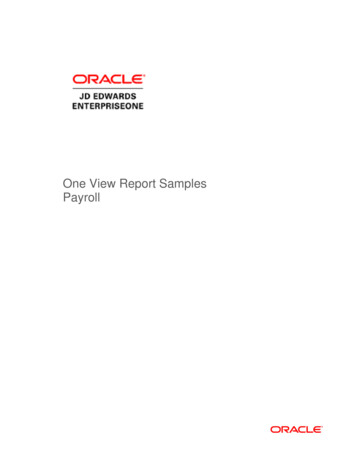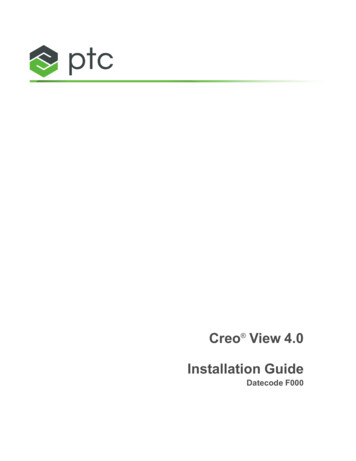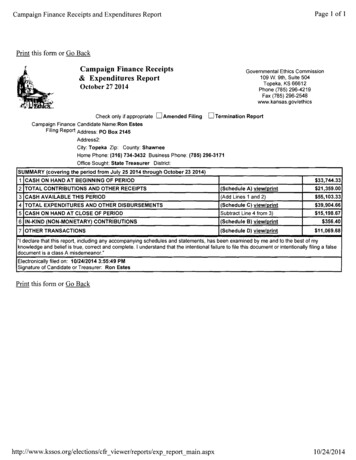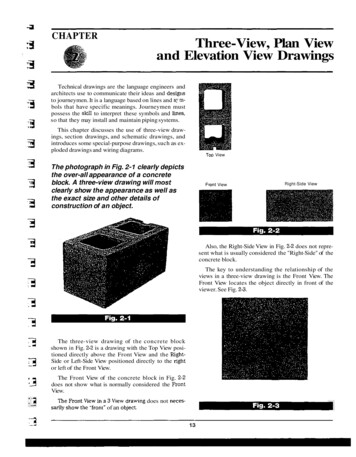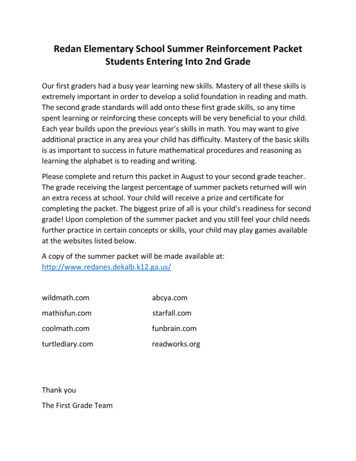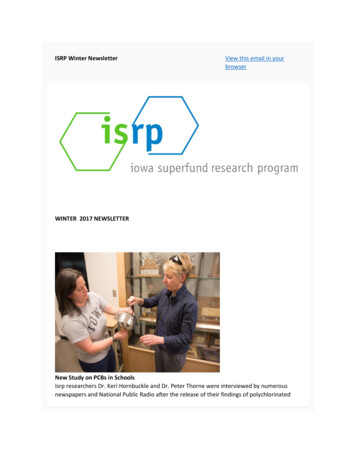
Transcription
ISRP Winter NewsletterView this email in yourbrowserWINTER 2017 NEWSLETTERNew Study on PCBs in SchoolsIsrp researchers Dr. Keri Hornbuckle and Dr. Peter Thorne were interviewed by numerousnewspapers and National Public Radio after the release of their findings of polychlorinated
biphenyls (PCBs) in schools in the journal Environmental Science and Technology.The study showed that PCBs are present in older schools and that the source of the PCBs ismost likely outdated building materials, such as window caulking and light ballasts.The study, which collected indoor and outdoor air samples at six schools in Iowa and Indianafrom 2012 to 2015, is the largest yet to examine airborne PCBs in schools. It shows that whilethe presence of PCBs can vary from school to school and even from classroom to classroom,children’s exposure rates are roughly the same in rural and urban areas.It also shows that exposure to PCBs by inhalation may be equal to or higher than exposurethrough diet, a finding that surprised researchers. Besides PCBs, researchers looked for thefirst time at OH-PCBs, chemical compounds similar to PCBs, in schools. Although there is stillmuch to learn about OH-PCBs and their potential health risks, some scientists believe theycould be more toxic than PCBs.Following publication of the article, representatives from the EPA and ATSDR and severalcommunity groups in the East Chicago area discussed the findings with staff.More information on PCBs and schools can be found on our Iowa Superfund ResearchProgram links page.Above photo, courtesy of Tim Schoon, shows Dr. Hornbuckle and Dr. Rachel Marek (left) witha passive sampler.Editor's Highlight Paper in Toxicological Sciences
A paper on PCBs and developmental neurotoxicity was picked as an Editor's Highlight in thejournal Toxicological Sciences. The research was a joint collaboration between researchers atthe University of Iowa, UC-Davis, and University of British Columbia. The lead author was Dr.Izabela Kania-Korwel from the isrp.Dr. Korwel and collaborators presented a study focusing on the various aspects ofneurodevelopmental toxicity of PCB metabolites. "Interestingly, the profiles of the OH-PCBmetabolites were significantly different depending on the parent PCB, type of tissue, and ageof exposure. These OH-PCBs can significantly influence the thyroid hormone homeostasis andinteract with the ryanodine receptors forming a likely mechanistic basis forneurodevelopmental effects of these compounds."The results of this study "clearly indicate that the underlying factors for neurotoxicity of thesecompounds are much more complex, if differences in enantioselective metabolism are takeninto account. This complexity will clearly influence the risk assessment for PCBs with respectto neurotoxicity." Martin van den Berg.Trainees Work and Learn in the CommunitySix Trainees did a road trip to East Chicago, Indiana to support the outreach activities of theIowa Superfund Research Program (isrp) at a junior high school. The students assisted AshleeJohannes, Community Engagement Coordinator for the isrp. Students taught 8th gradestudents at Joseph Block Junior High about polychlorinated biphenyls (PCBs) during theirscience class.East Chicago is home to several Superfund sites. The Indiana Harbor and Ship Canal, just a fewblocks from Block Junior High, is being dredged. Dredging first began in 2012 in the GrandCalumet River, which contains PCBs and is considered one of the most polluted in the country.
Trainees really enjoyed the chance to interact with junior high students. It was a good lessonon how toxic substances affect the surrounding community and how toxicologists can assistcommunities as a part of their job.External Advisory Committee MeetingOn October 3rd, the isrp held its External Advisory Committee (EAC) Meeting at the Universityof Iowa College of Public Health.The External Advisors provide important suggestions andrecommendations regarding the Iowa Superfund Research Program.In the morning, each Project and Core presented an update concerning their programs. Theafternoon session provided additional time for the advisors to make recommendations abouthow they would like the Center to proceed in the future.During the lunch hour, 22 posters were presented by isrp trainees to the EAC Advisors fortheir feedback. In addition to the EAC members, representatives from the EnvironmentalProtection Agency and the National Superfund Research Program were also present .Pictured above is isrp staff Andres Martinez (left), trainee Jessica Ewald (middle), and EACadvisor Dr. Terry Monks.
Reductive Dehalogenase Genes in Unenriched SedimentsIowa Superfund researchers from Project 4 and Project 5 recently published in the journalEnvironmental Science and Pollution Research the first study to find PCB reductivedehalogenase genes (RDase) in unenriched sediments.Twenty-seven sediment samples were taken from a former wastewater lagoon inAltavista,Virginia. The site is contaminated with a commercial mixture- Arolclor 1248.Comparison of PCB congener profiles in each sediment sample against the Aroclor 1248 PCBcongener profile reveals that the extent of PCB dechlorination varies within the lagoon. It alsoappears that PCB dechlorination processes had occurred at some point in the past.Enrichment of PCB-dechlorinating microorganisms from these sediments along withconcurrent application of molecular diagnostic tools is expected to reveal which RDase genesparticipate in PCB congener reduction.Two Trainees Awarded KC Donnelly Externships
Two trainees from the Iowa Superfund Research Program have been awarded KC DonnellyExternships from the NIEHS Superfund Program. The KC Donnelly Externships provide currentSRP funded graduate students/post-doc researchers translational experiences with other SRPfunded centers, government agencies, or other agencies (state, local, or Tribal).Eric Uwimana and Victoria Parker will receive support for up to three months consisting ofsupplies, travel, and housing costs for the duration of the externship and travel funds toattend the SRP Annual Meeting where they are invited to present their research.Eric will be doing his externship with Isaac Pessah, Ph.D., at the University of California,Davis.Through this externship, he will use a high-throughput screening approach to study therelationship between PCBs and liver disease. The externship will expand upon his current workby exploring the underlying mechanisms of how PCBs contribute to liver disease and byincluding experiments with liver cells from both mice and humans. He will evaluate speciesdifferences, important information for extrapolation from animal data to human risk.Victoria traveled to the University of Kentucky where she worked with Lisa Cassis, Ph.D. TheKC Donnelly externship will expand upon her current work with human adipocytes exploringimportant differences between human and rodent cell models in PCB metabolism and effects.Isrp Assists in the Community Reporting of Air PCBsThe Iowa Superfund Research Program, the Boston University Superfund Program (BUSRP),and three community groups formed a partnership of five project leaders to measure theamount of airborne PCBs in the New Bedford Harbor area. The three community groups werethe Toxics Action Center, Alternatives for Community and Environment (ACE), and the HandsAcross the River Coalition (HARC).
ACE and HARC developed research questions related to New Bedford Harbor and shared thesequestions with BUSRP. BUSRP engaged researchers at the Iowa Superfund Research Program,who have a long history of studying lower molecular weight PCBs and their sources. HARC’srole was to recruit air monitor hosts interested in New Bedford Harbor environmental healthconcerns.Two workshops were held with monitor hosts so that they could understand the datacollected. Monitor hosts worked in pairs with assistance from the Toxic Actions Center andBUSRP to translate the data. The hosts became much more confident in interpreting the dataand comparing them to data generated by the EPA. This outreach and cooperation model canbe used for other communities impacted by environmental pollutants.The complete article describing the results of their cooperation can be found in EnvironmentalScience and Pollution Research.Above image is courtesy of the Environmental Protection Agency.Isrp in Atlantic MagazineResearchers from the Iowa Superfund Research Program were included in an article in theAtlantic magazine about the history and evolution of benzene. This interesting article tracesthe history of benzene from 19th century Germany to 1929 production of PCBs to thediscovery of PCBs in the deepest part of the oceans. Six isrp researchers were cited in thearticle.
Above image is courtesy of Alexandra Loske.Risk Assessment CourseIsrp trainees participated in an Environmental Protection Agency (EPA) Risk AssessmentCourse at the University of Iowa on October 2, 2017. The daylong course was led by Dr. XabierArzuaga and Dr. Geniece Lehmann of the U.S. EPA.Trainees were given an introduction to risk assessment, an overview of human health riskassessment, learned how toxicology research is used in human health risk assessment, andwere given the chance to do a real risk assessment using the EPA's Exposure FactorsInteractive Resource for Scenarios Tool. Students received an EPA certificate at the end of thecourse.Former Trainee SpotlightThe former isrp trainee highlight for this edition will be Dr. Bingxuan Wang, a 2011 graduate ofthe University of Iowa Interdisciplinary Graduate Program in Human Toxicology.
"I'm a toxicologist at the consulting firm ToxServices. I workwith private industries, government agencies and nonprofitorganizations on a variety of projects involving qualitativeand quantitative risk assessments, such as establishingsafety levels of drinking water contaminants originated fromplumbing parts, and evaluating the safety and regulatorycompliance of food ingredients, cosmetic formulations,electronic devices, medical devices, and textile treatmentchemicals."I also evaluate the human health and environmental safetyof household cleaning products under the U.S. EPA's SaferChoice program, building components (such as elevators,cables, insulating materials) under the Cradle to Cradle certification program, and chemicals(such as pesticides, preservatives, plasticizers) using the GreenScreen for Safer Chemicalsparadigm. In doing this, I help industries select safer ingredients in their products and removechemicals that are harmful to human health or the environment."Good job, Bingxuan, keep up the good work!Copyright 2017 The University of Iowa Superfund Research Program, All rights reserved.Our mailing address is:Iowa Superfund Research Program, the University of Iowa, 100 Oakdale Campus, #219 IREH,Iowa City, IA 52242-5000Want to change how you receive these emails?You can update your preferences or unsubscribe from this list
Isrp researchers Dr. Keri Hornbuckle and Dr. Peter Thorne were interviewed by numerous . through diet, a finding that surprised researchers. Besides PCBs, researchers looked for the . Eric Uwimana and Victoria Parker will receive support for up to three months consisting of suppli
